Contents
Recently, blackberry culture has become very popular in private gardening. There are already about three hundred varieties of this berry in the world, and the assortment is growing every year, so choosing the best blackberry varieties for your home garden is not an easy task. A plant can be classified according to many parameters, but the gardener is primarily interested in such qualities as unpretentiousness in care, productivity, and also the taste of fruits. This article provides a description of fairly new, but very tasty and very productive blackberry varieties, and their short description.
Early varieties
Early varieties of blackberries are characterized by ripening at the end of June. As a rule, such berries are sour, but this is the best option for harvesting and market sales.
Blackberry Arapaho
The earliest berry of the blackberry season – its ripening falls on the second decade of June. A hybrid of American selection, bred in 1993 for home gardening and commercial purposes. Bushes of medium height (up to 1,5 m), vertical shoots, without thorns. The fruits are large (6-10 g), conical in shape, black in color with a shiny surface. The taste is multifaceted, sweet, without acid, the aroma is pronounced blackberry. Resistance to disease and frost is high.
Blackberry Osage
A modern hybrid obtained in 2012 by breeders from the famous University of Arkansas. Fruiting begins in mid-June, the berries have an excellent sweet taste and light aroma. The branches are powerful, without thorns, the fruits are round, with an average weight of 5-6 g. The average yield is 3,5-5 kg / bush. The Osage variety is resistant to diseases, but does not tolerate low temperatures well – at -13 ° C it needs shelter.
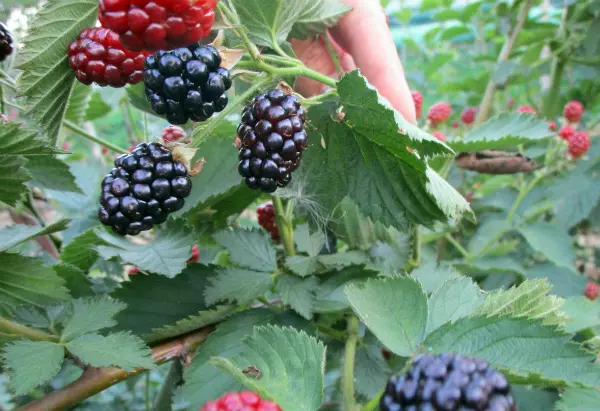
Blackberry Black Bat
The hybrid of the American selection is also known as Blackberry. This blackberry variety is characterized by creeping prickly shoots 3-6 m long. The fruits are large (3-5 cm long and weighing 10-15 g), elongated, shiny, sweet in taste with a slight sourness, have a pronounced aroma.
Blackberry Black Beauty
In some ways, this is a variation of the previous variety with a difference in the size and shape of the berries. The drupes are black, shiny, look like small barrels, slightly elongated, with an average weight of 12-15 g, but there are specimens of 20 g each. At the stage of full maturity, the berries are sweet, without acid, do not flow, are well transported.
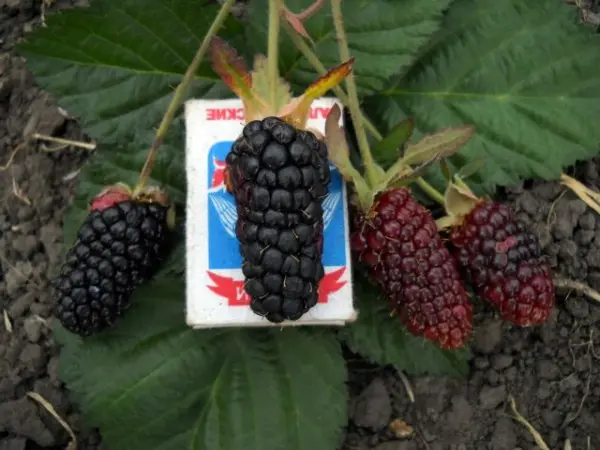
Blackberry Ebony
High-yielding – up to 15 kg from one bush – a hybrid that ripens in the last decade of June. The bushes have a compact appearance, the shoots are powerful, directed vertically. The berries are large (5 cm long and 2 cm in diameter), black in color, sweet in taste with a delicate aroma. The variety is resistant to diseases, tolerates frosts well, but in conditions of severe frosts it requires shelter.
Hybrid Blask Perl
A novelty in the line of blackberry of American selection. This blackberry is a mix of several large-fruited hybrids and seedlings of the Orus variety. Shoots creeping, thorny at the bottom, and at the top without thorns. The fruits are oval, elongated, large (8-12 g), shiny, black in color and have an outstanding dessert taste.
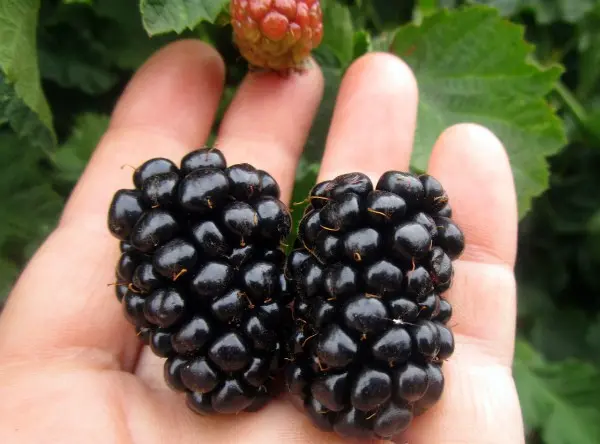
Medium-ripening varieties
Fruiting in July – early August is typical for a mid-ripening berry crop. This group includes the following varieties of medium ripening.
Blackberry Chachanska Bestrna
Variety of Serbian selection of medium-late ripening. Bushes vigorous, shoots without thorns. The fruits are large (9-15 g), the surface is shiny, in full maturity they are black in color, easily removed from the branches, more than 80 drupes ripen simultaneously on one lash. The taste of berries is excellent – very sweet, dessert, without characteristic acidity and astringency.
Blackberry Doyle
The newest thornless variety Doyle is the pride of American breeders. The bush is compact, the lashes are long (up to 4 meters), horizontally directed. The drupes are very fragrant, large (8-10 g), elongated, rich black in color with a glossy surface. Fruiting is stretched – from early July to mid-September. The yield is maximum. Characterized by high resistance to disease and frost.
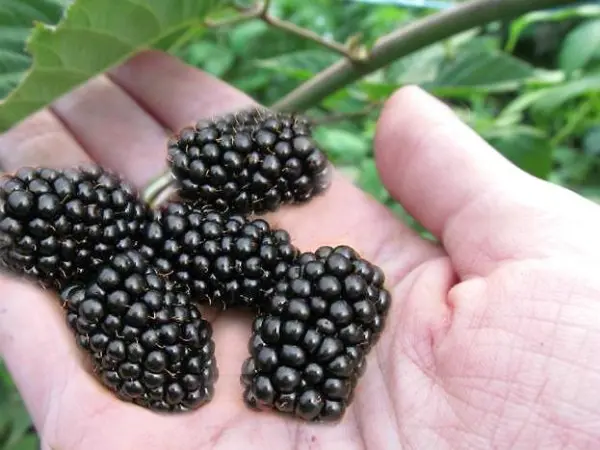
Blackberry Kitatini
One of the most productive varieties – the productivity of one bush is 20 kg, and up to three hundred berries can be removed from one branch at the same time.
Bushes are powerful. Creeping shoots without thorns necessarily need supports. The fruits are large (up to 15 g), elongated conical in shape, dessert, very sweet in taste. Easily tolerates both drought and frost.
Blackberry Guy
A new hybrid of Polish selection, cultivated since 2008. Berries of medium size (6-7 g), elongated, glossy surface, black color, sour-sweet taste. Upright powerful lashes (up to 3 meters in height) require trimming and shaping. Average yield – up to 12 kg / bush. It has above average disease and frost resistance.
Blackberry Darrow
The thornless hybrid of American selection is considered one of the most frost-resistant – it can withstand temperatures down to -34 ° C. The whips are powerful, erect (2-3 m), but they need supports. The berries are medium-sized (4-6 g), oblong, black in color, sweet and sour in taste, which become insipid when overripe.
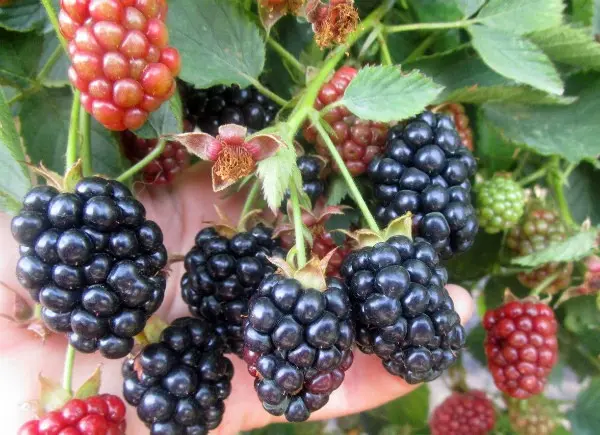
Variety Cumberland
Cumberland is a black raspberry, although the berry looks more like a blackberry in appearance. It was bred by American breeders back in the 80s, but it has recently begun to be grown in our gardens. Raspberry Cumberland is famous for its rich vitamin composition and useful properties: it has an antimicrobial, antiviral effect, improves immunity.
Cumberland berries are not large (2-3 g), covered with a wax coating, very sweet, they taste like mulberries – they have absolutely no acid, which is why children love them so much. Productivity is high – more than 10 kg / 1 bush. Frost resistance is also on top – it easily tolerates temperatures below -30 ° C. Raspberry Cumberland has erect, long (up to 3 m) branches with small thorns, needs to be grown on a support.
Blackberry Flint
The positive quality of this variety is high winter hardiness and immunity to diseases and pests. The bush is compact, the shoots are low (up to 1,5 m). Fruits of medium size (5-6 g), blue-black color, excellent sour-sweet taste. They ripen almost simultaneously, are transportable, have a good presentation.
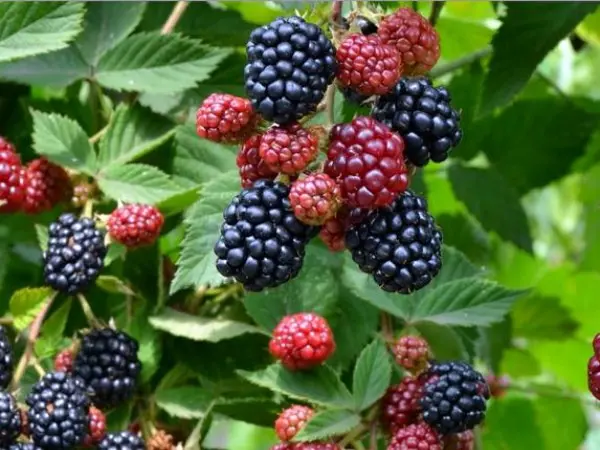
Late varieties
Late varieties include varieties that produce a crop in late August – September.
Blackberry Abundant
Variety of domestic selection (bred by I.V. Michurin) with more than a century of history. One of the most winter-hardy and undemanding to conditions – grows and bears fruit in one place up to 15 years. The bushes are powerful, and the shoots are creeping, prickly. The drupes are medium-sized, black with a bluish tint. The yield is low – about 3 kg per bush, but even with such indicators you should not sound the alarm – you just need to water and fertilize more often, and then the number of berries will increase.
Blackberry Gazda
A hybrid of Polish selection, allowed for cultivation since 2003. The bush is vigorous, the shoots are slightly prickly. The berries are medium in size (5-7 g), at the stage of full ripeness they are black, with a glossy surface, sweet in taste with a slight sourness, suitable for market sale. The yield is high.

Blackberry Orkan
A hybrid of Polish selection, grown since 1998. The bush is compact, shoots are distinguished by strong growth, without thorns. The berries are large (up to 15 g), cylindrical elongated, black in color, with a glossy surface, very sweet. Blackberry Orkan is resistant to all diseases, but in climates with severe frosts it needs shelter.
Blackberry Smutstem
A hybrid of American selection, bred back in 1966. This is the very first thornless variety, which was a sensation at the time. Semi-creeping shoots (up to 3 m), need support. The berries are large (weighing 5-10 g and 3-4 cm in length), conical in shape, glossy, black in color, harmonious sweet taste with moderate sourness. A very high yield is characteristic – 17-25 kg, winter hardiness is average.
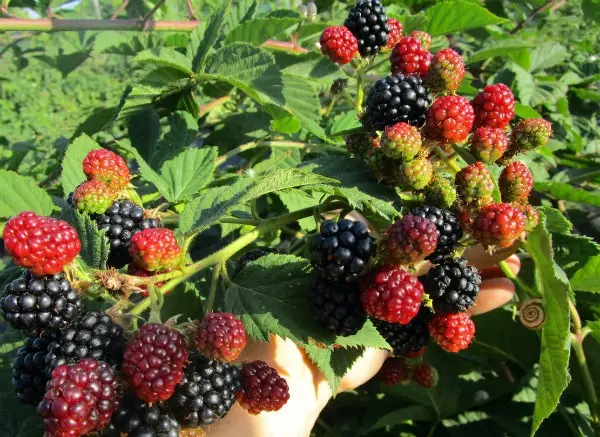
Blackberry Enchantress
Late variety of domestic selection. Semi-spreading shoots (up to 3 m), with small thorns. The berries are medium (weighing 5-7 g and 3 cm in length), oval, black, with a slight purple tint, sweet and sour. The yield is average. Blackberry Enchantress tolerates frost and drought well, resistant to a number of diseases.
Black Prince
The most unpretentious bush variety, for the fruiting of which only minimal care is required. It grows well in the shade, the yield is high – up to 25 kg / 1 bush. This blackberry is bushy, compact, comes across both without thorns and slightly thorned. The berries are elongated, conical, rather large (up to 10 g), black in color, sweet dessert taste, well transported.
Blackberry Loganberry
This is a hybrid of blackberry and raspberry, combining the features of both species. Like its raspberry relative, this blackberry is red with a slight bluish tinge to the top of the berry, but with a distinct blackberry flavor. Spreading bushes, stems without thorns, low (up to 2 m), but need support. The fruits are large (10-12 g), elongated, slightly conical, very sweet. The yield is high – 10 or more kg. Shelter is required in winter.
Video “About the best varieties of blackberry culture”
Watch a video about the range and yield of blackberry crops.
Repair varieties
The remontant variety appeared not so long ago, but has already managed to arouse genuine interest in gardeners and even farmers. In the CIS countries, in particular in Ukraine and Our Country, the first remontant seedlings appeared in 2011. To date, these new blackberry varieties number no more than a dozen names, of which five of the most famous and proven in yield can be distinguished.
Ruben
One of the most large-fruited remontant hybrids – its berries reach a mass of 10-16 g. The yield, taste and commercial qualities of the berries are also at their best. Fruiting is possible both on the shoots of the current year and on biennials. The first ones give a harvest from the end of August to the end of October, and the biennial ones – from June to the end of July. The shoots of the plant are powerful, arranged vertically, they do not need support. The culture is resistant to diseases and pests, it easily tolerates severe frosts.
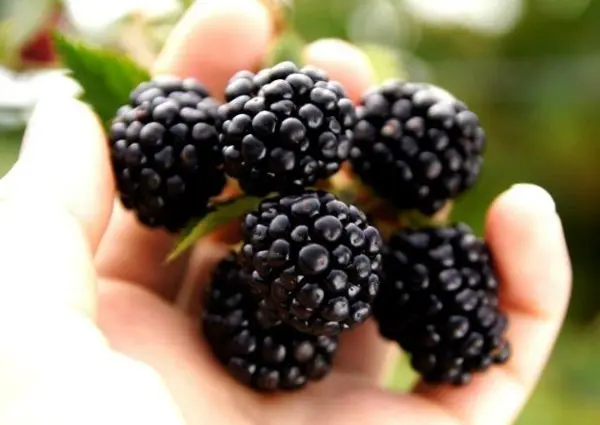
Prime Arc
An American variety, bred in 2009. The shoots of the bush are erect, up to 2 m in height, powerful and prickly. The berries are large (7-10 g), oblong in shape, the flesh is dense, but very juicy and sweet. Fruits on the shoots of the current year. The yield is high, the ripening of berries occurs in two waves: the first time in mid-June, and the second – from mid-August until the first frost.
Prime Jim
Also an American variety, bred a little earlier – in 2004. Shoots are strong, erect, with thorns. The berries are large (up to 10 g), elongated conical shape, dense, multifaceted sweet and sour taste. During the flowering period, the bush has a high decorative effect – it blooms with large pinkish-white flowers. The yield is average.
Prime Yang
Another hybrid of this series. Among the remontant varieties, it is considered the earliest – fruiting on the branches of the current year begins in early July. Shoots are straight, powerful, prickly. The berries are not very large (6-7 g), slightly elongated, dense, taste very sweet, smell like an apple. Resistance to cold and diseases is average.
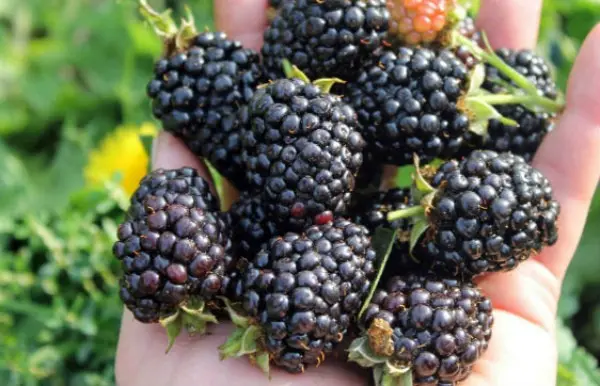
Black Magic
According to gardeners, this is one of the highest-yielding remontant varieties. It bears fruit on annual shoots in two crops. The bush is erect, low (1,2-1,5 m), the shoots are slightly prickly, strong, but under the weight of berries they can lie down. The culture is resistant to diseases, tolerates frost well, with full pruning it can winter without shelter. The berries are large (11-15 g), very juicy and sweet (15,1% sugar), well transported.
A positive feature of all remontant varieties is that they bear fruit on the shoots of the first year of life – thus, there is no need for autumn pruning and sheltering branches. Thanks to this quality, plants tolerate winters more easily and do not freeze out.
When preparing blackberries for the winter, they simply cut out all the shoots under the root, and cover only the roots, although shelter is not necessary in southern or temperate climates. In addition, the cultivation of remontant hybrids is also allowed for a two-year cycle. If the fruiting lashes are not cut out, but only shortened, then next year you can get a double crop – on last year’s branches in June, and on new lashes from July until autumn itself.
Video “Growing garden blackberries”
In this video, an expert shares the secrets of successfully growing blackberries in the garden.









